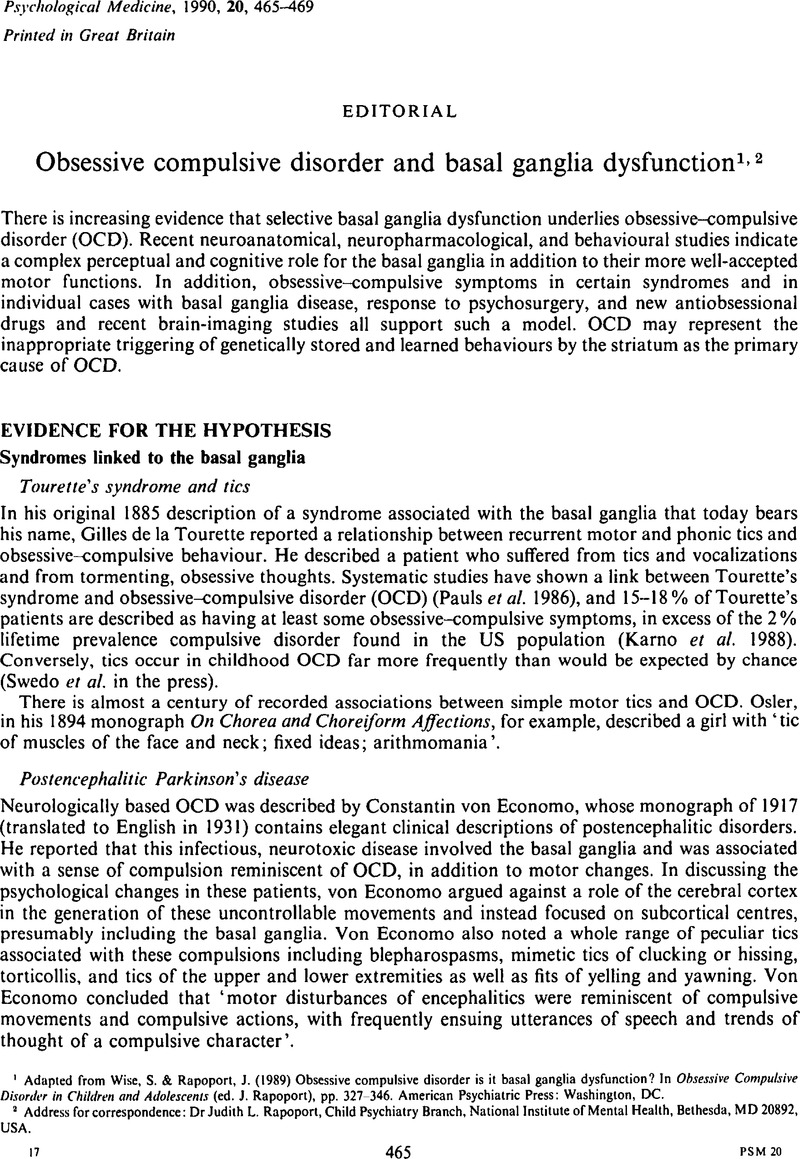Crossref Citations
This article has been cited by the following publications. This list is generated based on data provided by Crossref.
Voeller, Kytja K.S.
1991.
Toward a Neurobiologic Nosology of Attention Deficit Hyperactivity Disorder.
Journal of Child Neurology,
Vol. 6,
Issue. 1_suppl,
p.
S2.
Pantelis, Christos
Barnes, Thomas R. E.
and
Nelson, Hazel E.
1992.
Is the Concept of Frontal–Subcortical Dementia Relevant to Schizophrenia?.
British Journal of Psychiatry,
Vol. 160,
Issue. 4,
p.
442.
Tallis, Frank
and
de Silva, Padmal
1992.
Worry and obsessional symptoms: A correlational analysis.
Behaviour Research and Therapy,
Vol. 30,
Issue. 2,
p.
103.
DIMITSOPULOS, THERESA
and
KURLAN, ROGER
1993.
Tourette's Syndrome and Nicotine Withdrawal.
The Journal of Neuropsychiatry and Clinical Neurosciences,
Vol. 5,
Issue. 1,
p.
108-a.
1993.
Tourette's syndrome and nicotine withdrawal.
The Journal of Neuropsychiatry and Clinical Neurosciences,
Vol. 5,
Issue. 1,
p.
108b.
ESCOBAR, RODRIGO
and
BERNARDO, MIGUEL
1993.
Schizophrenia, Obsessive-Compulsive Disorder, and Tourette's Syndrome: A Case of Triple Comorbidity.
The Journal of Neuropsychiatry and Clinical Neurosciences,
Vol. 5,
Issue. 1,
p.
108.
Hay, P.
Sachdev, P.
Cumming, S.
Smith, J. S.
Lee, T.
Kitchener, P.
and
Matheson, J.
1993.
Treatment of obsessive‐compulsive disorder by psychosurgery.
Acta Psychiatrica Scandinavica,
Vol. 87,
Issue. 3,
p.
197.
Eggers, Christian
Schepker, Renate
and
Oades, Robert
1993.
Case report: Exacerbation and provocation of tics by imipramine and sulpiride.
European Child & Adolescent Psychiatry,
Vol. 2,
Issue. 3,
p.
169.
1993.
Schizophrenia, obsessive-compulsive disorder, and Tourette's syndrome: a case of triple comorbidity.
The Journal of Neuropsychiatry and Clinical Neurosciences,
Vol. 5,
Issue. 1,
p.
108a.
Vincent, Annick
Baruch, Philippe
Pourcher, Emmanuelle
and
Vincent, Pierre
1994.
Implication Des Noyaux Gris Centraux Dans Le Trouble Obsessionnel-Compulsif: Une Revue.
The Canadian Journal of Psychiatry,
Vol. 39,
Issue. 9,
p.
545.
Harris, Gordon J.
Hoehn‐Saric, Rudolf
Lewis, Robert
Pearlson, Godfrey D.
and
Streeter, Chris
1994.
Mapping of SPECT regional cerebral perfusion abnormalities in obsessive‐compulsive disorder.
Human Brain Mapping,
Vol. 1,
Issue. 4,
p.
237.
Lucey, J.V.
1994.
BAP/SKB Young Psychopharmacologist Award Towards a neuroendocrinology of obsessive-compulsive disorder.
Journal of Psychopharmacology,
Vol. 8,
Issue. 4,
p.
250.
Summers, Craig
1995.
The role of discounting in global social issues.
Behavioral and Brain Sciences,
Vol. 18,
Issue. 1,
p.
144.
Shimoff, Eliot
1995.
Distinguishing between acts and patterns.
Behavioral and Brain Sciences,
Vol. 18,
Issue. 1,
p.
142.
Overskeid, Geir
1995.
Thinking is a difficult habit to break.
Behavioral and Brain Sciences,
Vol. 18,
Issue. 1,
p.
138.
Hineline, Philip N.
1995.
The extended psychological present.
Behavioral and Brain Sciences,
Vol. 18,
Issue. 1,
p.
128.
Silverstein, Albert
1995.
Teleological behaviorism and internal control of behavior.
Behavioral and Brain Sciences,
Vol. 18,
Issue. 1,
p.
142.
Branch, Marc N.
1995.
When is a pattern a pattern?.
Behavioral and Brain Sciences,
Vol. 18,
Issue. 1,
p.
123.
Baum, William M.
1995.
Patterns yes, agency no.
Behavioral and Brain Sciences,
Vol. 18,
Issue. 1,
p.
122.
Zentall, Thomas R.
1995.
The cost of an interrupted response pattern.
Behavioral and Brain Sciences,
Vol. 18,
Issue. 1,
p.
147.



